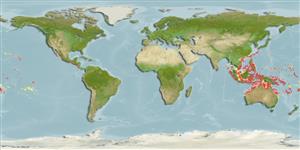Actinopterygii (ray-finned fishes) >
Perciformes (Perch-likes) >
Microdesmidae (Wormfishes) > Ptereleotrinae
Etymology: Ptereleotris: Greek, pteron = wing, fin + The name of a Nile fish, eleotris (Ref. 45335).
Environment / Climate / Range
Ecology
Marine; reef-associated; depth range 3 - 50 m (Ref. 27115), usually 6 - 30 m (Ref. 48637). Tropical; 21°C - 27°C (Ref. 27115), preferred ?; 30°N - 30°S
Pacific Ocean: Philippines to the Line Islands, north to southern Japan, south to northwestern Australia and New South Wales.
Size / Weight / Age
Maturity: Lm ? range ? - ? cm
Max length : 12.0 cm TL male/unsexed; (Ref. 9710)
Dorsal
spines
(total): 7;
Dorsal
soft rays
(total): 24-26;
Anal
spines: 1;
Anal
soft rays: 22 - 25;
Vertebrae: 26. Pale blue to light bluish gray in color. Operculum with 2 broad, curved, bright blue bands. 4 to 6 median barbels (like bumps in juveniles). 2nd spine of 2nd dorsal fin elongated; caudal fin of adults with trailing filaments; diagonally elongate red to violet spot usually present on lower base of pectoral fin.
Inhabits coastal reef slopes in a depth range of about 6 to 30 meters depth (Ref. 48637). Found over rubble and sand near reefs. Usually seen in pairs occupying the same burrow. It uses burrows made by alpheid shrimps which live in association with gobies of the genus Amblyeleotris, but does not interact with the shrimps. Feeds on zooplanktons (Ref. 89972).
Life cycle and mating behavior
Maturity | Reproduction | Spawning | Eggs | Fecundity | Larvae
Randall, J.E. and D.F. Hoese, 1985. Revision of the Indo-Pacific dartfishes, genus Ptereleotris (Perciformes: Gobioidei). Indo-Pac. Fish. (7):36 p. (Ref. 528)
IUCN Red List Status (Ref. 115185)
CITES (Ref. 94142)
Not Evaluated
Threat to humans
Harmless
Human uses
Aquarium: commercial
More information
Common namesSynonymsMetabolismPredatorsEcotoxicologyReproductionMaturitySpawningFecundityEggsEgg development
ReferencesAquacultureAquaculture profileStrainsGeneticsAllele frequenciesHeritabilityDiseasesProcessingMass conversion
Tools
Special reports
Download XML
Internet sources
Estimates of some properties based on models
Phylogenetic diversity index (Ref.
82805): PD
50 = 0.5000 [Uniqueness, from 0.5 = low to 2.0 = high].
Bayesian length-weight: a=0.00389 (0.00180 - 0.00842), b=3.12 (2.94 - 3.30), in cm Total Length, based on all LWR estimates for this body shape (Ref.
93245).
Trophic Level (Ref.
69278): 3.4 ±0.4 se; Based on size and trophs of closest relatives
Resilience (Ref.
69278): .
Vulnerability (Ref.
59153): Low vulnerability (10 of 100) .
